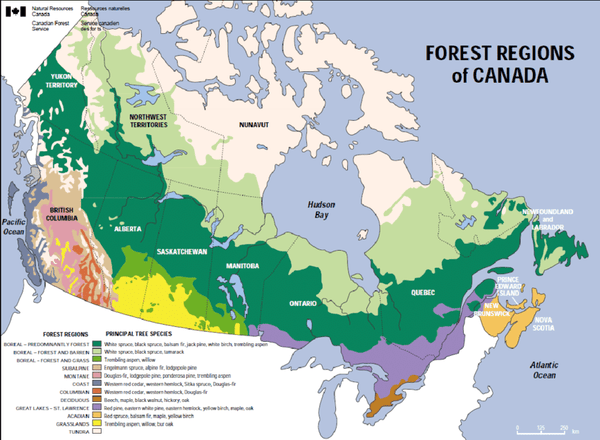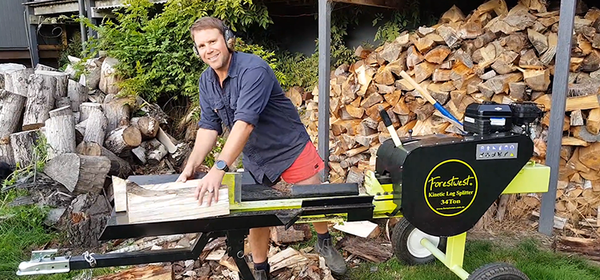Forestwest Kinetic Log Splitter series features a wide range splitting capacity from 10ton to 34ton, with both electric and petrol models available. They are designed for firewood of different species and log sizes.
If you’re struggling to decide which model of the Forestwest Kinetic Log Splitters should do the job nicely, this article might give you some hint.
Firewood Species in Canada
There’re many different types of wood species in Canada. Below the figure shows the map of “Forest Regions of Canada”, and can give you a rough idea what types of wood can be most commonly sourced at your local area.

Forest Regions of Canada (Natural Resources Canada 2007, Forest regions classifications. Retrieved July 18, 2011, from ecosys.cfl.scf.rncan.gc.ca/images/classif/forest-reg2_e.pdf)
How should I know if the wood I have is a good firewood or not? Well, there’re basically 5 factors that are commonly used to measure firewood quality: BTUs, Smoke, Spark Output, Smell and Coaling Quality. Basically, the top 3 firewood species in North America are Black Locust, Hickory and White Oak.
We’re not going to expand too much of this part in this article, if you’re interested, please check below the 2 article-links for some more detailed explanations:
Introduction of some best to worst firewood in North America
https://firefightergarage.com/best-types-of-firewood/
https://burlybeaver.com/firewood-best-to-worst/
As a general rule, hardwood will burn longer than softwood, but it takes longer for the wood to season/dry out. For example, Red Oak normally takes 2 years to season, while other softwoods only need 1 year (So always plan to season your firewood in advance). Softwood is always easy kindling to start fire, while hardwood may not catch fire that easily. Sometimes a mix of both could be a good idea.
Janka Hardness Scale
Now we got some idea of what kind of wood we have in hand or what type of firewood to source for. Let’s consider splitting the log then.
For all types of log splitters, there’s a maximum limit on log diameters and lengths, however we are not able to label the limitation for all types of wood. The general rule of thumb is, the harder the wood is, the smaller the log should be put onto the log splitter.
However, the wood hardness is still some vague concept. In order to simplify & quantify this question, we’d like to introduce the “Janka Hardness Rating Scale”:
“The Janka hardness test measures the amount of force required to embed a 0.444 inch (11.28mm) diameter steel ball into a piece of wood to the depth of half the ball's diameter. The results are measured with various units, in the United States the scores are represented in pounds-force(lbf), in Europe, it is in kilograms-force (kgf), and in Australia, it is shown in newtons (N).” And Janka rating is the Janka value in newtons divided by 1000. Rating range could be 0 – 17. For example, the rating for Hickory is 8.1.
Below the table is a collection of some common wood species in North America.
|
Wood Species |
Janka Value in Pound-Force (Newtons) |
|
Osage Orange |
2,040 lbf (9,100 N) |
|
Jarrah |
1,910 lbf (8,500 N) |
|
Hickory, Pecan, Satinwood |
1,820 lbf (8,100 N) |
|
Black Locust |
1,700 lbf (7,600 N) |
|
Sweet Birch |
1,470 lbf (6,500 N) |
|
Sugar Maple, Hard Maple |
1,450 lbf (6,400 N) |
|
1,360 lbf (6,000 N) |
|
|
1,320 lbf (5,900 N) |
|
|
American Beech |
1,300 lbf (5,800 N) |
|
Red Oak |
1,290 lbf (5,700 N) |
|
Yellow Birch |
1,260 lbf (5,600 N) |
|
1,010 lbf (4,500 N) |
|
|
950 lbf (4,200 N) |
|
|
Red Maple |
950 lbf (4,200 N) |
|
Paper Birch |
910 lbf (4,000 N) |
|
Eastern Red Cedar |
900 lbf (4,000 N) |
|
Southern Yellow Pine (Longleaf) |
870 lbf (3,900 N) |
|
Sycamore |
770 lbf (3,400 N) |
|
Douglas Fir |
660 lbf (2,900 N) |
|
Alder |
590 lbf (2,600 N) |
|
Chestnut |
540 lbf (2,400 N) |
|
Yellow Poplar, Poplar |
540 lbf (2,400 N) |
|
Hemlock |
500 lbf (2,200 N) |
|
Western White Pine |
420 lbf (1,900 N) |
|
Basswood |
410 lbf (1,800 N) |
|
Eastern White Pine |
380 lbf (1,700 N) |
Which Model to Choose
Forestwest Kinetic Log Splitters have tested Jarrah (Janka rating 8.5) on all models in Australia, and based on our testing results, all the models can easily handle Jarrah up to the maximum log sizes labelled on the machine. Although Jarrah may be the “softest” type of wood in Australia, however, checking its position in the rating table, it is still a mid-hard wood overall.
Considering that most of the “Hardwood” in Canada, like Hickory, Black Locust & Hard Maple, lies in the rating range of 6.0 - 8.5 (let alone those softwood species like birch, red cedar, douglas fir, pine, etc.), we’d be very confident to say that our machine can handle most of the wood pieces thrown on the Forestwest Kinetic Log Splitters, and efficiently finish each spitting round in 2-3 seconds.
Even if, by any chance, you’ve got some very hard wood, or some tricky knotty logs, that the log splitter cannot split at the first go, you may try a couple of more times and it may split eventually.

Please check Max. splitting dimensions of all the kinetic log splitter models available at Forestwest Canada in below table:
|
Product Name |
Max. Log Length |
Max. Log Diameter |
|
10T Kinetic Log Splitter 2HP Electric |
16” |
12” |
|
12T Kinetic Log Splitter 2HP Electric |
16” |
14” |
|
15T Kinetic Log Splitter 2HP Electric |
16” |
16” |
|
18T Kinetic Log Splitter 3HP Petrol |
16” |
16” |
|
34T Kinetic Log Splitter 6.5HP Petrol |
28” |
24” |
To sum up, check what type of wood you have or planning to obtain first, get a rough dimension of the log and then decide whether you’d like a petrol or electric model. Based on your budget, check the specification data on Max. log diameter and length on each of the model to locate the most suitable model for your need.
Or, of course, you’re always welcome to ask our friendly staff in store, over the phone, or online for help.
Any questions, please do not hesitate to: visit our store in Mississauga, give us a call at 1-800-868-8997, or Email to sales@forestwest.ca.

